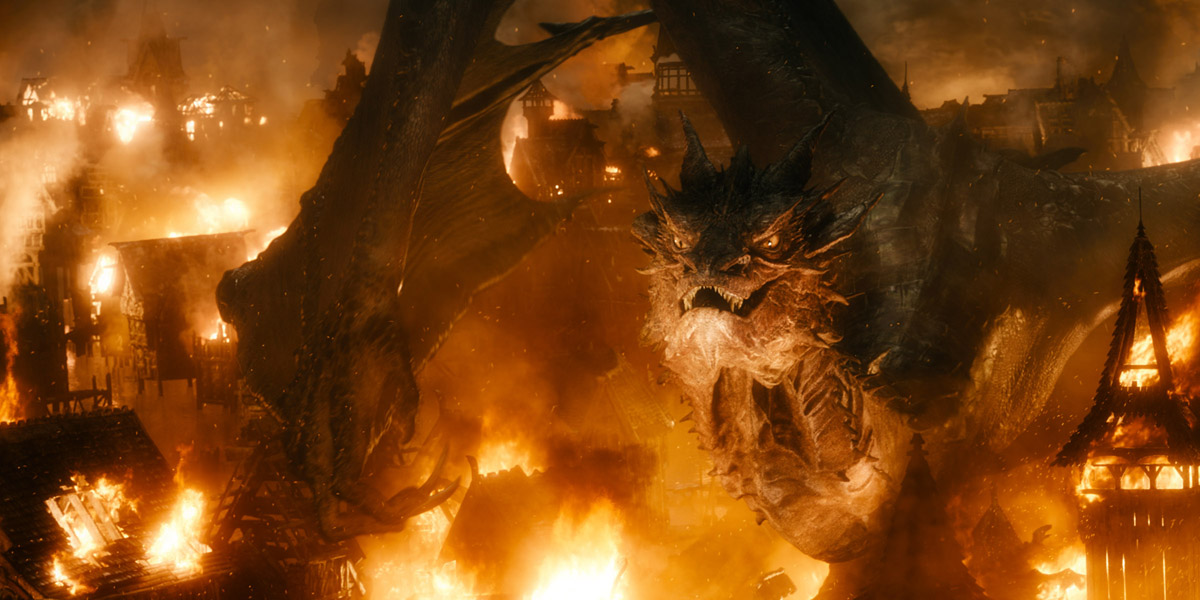The Hobbit: The Battle of the Five Armies, 2014, New Line Cinema. Directed by Peter Jackson. Starring Martin Freeman, Ian McKellen, Richard Armitage, Orlando Bloom, Cate Blanchett, Lee Pace, Luke Evans.
Perhaps I’m being mean, but on
some levels, The Hobbit was always
going to be somewhat of a disappointment. The
Lord of the Rings breathed new life into fantasy and changed the game for
blockbusters over the course of the decade in terms of aesthetic and marketing
a trilogy. It was bold, exciting and showed what could be done with a bold,
exciting director and a cast ready and willing to throw themselves into a world
that, treated with too much reverence or too much flippancy, could have just
looked a bit silly.
Eleven years since Return of the King, Battle of the Five Armies has taken the final bow for Middle Earth,
and though it’s not quite with a whimper, it’s certainly not with the same
bang. Much has changed in fantasy since 2003 and The Hobbit has never quite managed to stake its claim away away from Lord of the Rings and its ever lengthening shadow.
After Smaug has been desolated
himself, people start to take a lot of interest in the Lonely Mountain and the
riches therein, with just the one line of dialogue given to how this mountain
is actually the gateway to the evil kingdom of Angmar (which is why two lots of
Orc army want it). Thorin, overcome with all that glitters, backs away from his
promise to the people of Laketown to share Smaug's wealth and decides it’ll be much
nicer kept all to himself. Thranduil (Lee Pace, manfully battling with the
largest eyebrows in modern cinema) wants a necklace with special gems in it and
will quite cheerfully wage war over them, despite not mentioning them before or since. Some more dwarves turn up to lend Thorin
a hand and then the film meanders as various creatures hobble each other under
a moody sky.
 |
| Hi friend! We have very little motivation to be here! |
So really, in the conclusion to
the Middle Earth saga, there’s a battle, a bit with a dragon and Bilbo doing
his very best John Watson impression. How they managed to cram this all into
two and a half hours is a miracle of editing.
It all feels very tacked on,
which is a problem that stems from the source material. In the book, Bilbo
misses the battle entirely, and so therefore does the reader. However, the previous films
spent so long leading up to Smaug, when he’s dismissed in a spectacular pre-credits scene, there is a sense of a scramble to keep everyone’s interest. If
there was more build up to the bad guys in Angmar, maybe there wouldn’t be such a
feeling of loss when the dragon goes down, but as it stands the Big Bad is gone
before we have a bigger bad to take his place.
Which leads me to the good side
of Five Armies; it’s chock-a-block
with really cool bits, Smaug being its crowning glory. Benedict Cumberbatch is obviously having an enormously good time being the most awesome dragon ever and
he is breathtaking as he takes out an entire town in three minutes. Legolas,
after a wobbly start in the previous film, is in full swing here; remember how
cool it was when he took down a battle elephant in Return of the King? He’s way cooler here, unburdened with clunky
dialogue this time around as he lets his sword do the talking – his fight
scenes are full of air punching moments and it’s nice to see him kick ass and
take names again. Even Galadriel gets to show her awesome side in a scene that
highlights just how terrifyingly powerful she really is.
 |
| I don't have anything in particular to say here, I just wanted to show you how cool Smaug is |
And the ending is perfect. This,
more than all of the portentous chatter about a gathering darkness, ties this trilogy to
The Lord of the Rings. It’s beautifully
judged, brimming with affection and really lifts the entire film. Without it,
it could have been quite unsatisfying. Now, it really does feel like things
have come to a close that can leave people happy.
No, it’s not another Lord of the Rings and I doubt it will
inspire a generation of filmmakers to get out there and make their own mark on
the cinematic landscape. But it’s fun, it’s worth seeing on the biggest screen
you can find and it’s one more trip into Middle Earth before Peter Jackson puts
his toys away for good.




